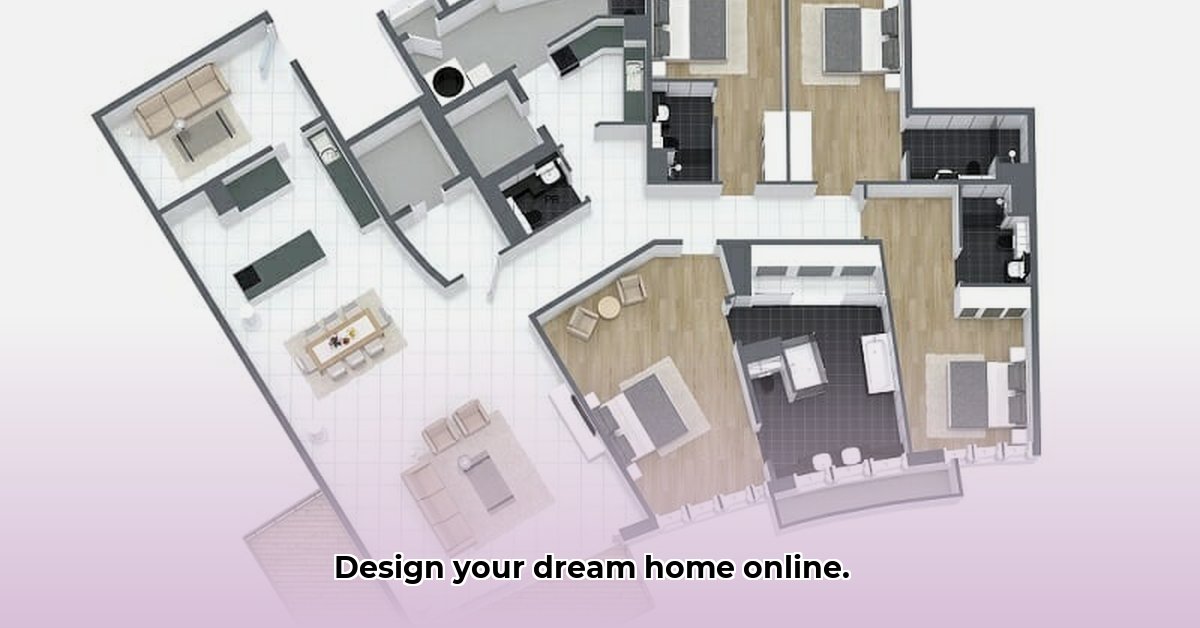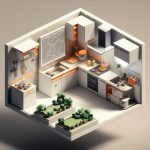Dreaming of a new home or office space? Before you even think about paint colors, you need a killer floor plan. But with so many online tools out there, choosing the right one can be a headache. This guide compares popular options like Canva, Planner 5D, and Floor Plan Creator – to help you find the perfect fit, whether you’re a DIY enthusiast or a professional designer. We’ll break down their features, ease of use, pricing, and ideal skill level. Ready to turn your dream space from idea to reality? Let’s dive in! For more options, check out other online floor plan tools.
Interior Design Floor Plans: Finding the Right Software
Choosing the right software to create your interior design floor plans can feel overwhelming. Countless options promise the world. To help you navigate this landscape, we’ve put popular choices – Canva, Planner 5D, and Floor Plan Creator – head-to-head. Let’s see which one best suits your digital design and layout needs!
Canva: Simplicity and Visual Appeal
If you’re looking for something simple and visually engaging, Canva is a solid choice. Think of it as a user-friendly digital canvas. The drag-and-drop interface is incredibly intuitive, even for those less tech-savvy. It’s perfect for quickly sketching out basic floor plans, brainstorming ideas, and presenting concepts with visual flair.
Pros:
- Ease of Use: The user-friendly interface is easy to master, eliminating a steep learning curve, which is great if you are just starting out.
- Visual Appeal: Canva’s design-centric approach ensures visually polished floor plans, which is a huge plus for presentations. Aesthetically pleasing designs are easily accessible.
- Affordability: The free version offers a great starting point, making it accessible even with budget constraints.
Cons:
- Limited Precision: Not ideal for projects requiring absolute accuracy, blueprints for example. Canva prioritizes overall layout over precise dimensions.
- Basic Features: Don’t expect advanced tools or complex functionalities; if you are a professional user, it might be easier to jump to the next product.
- Not Ideal for Complex Designs: Intricate designs with detailed specifications might be challenging to create in Canva.
Planner 5D: Versatility and 3D Visualization
Planner 5D adopts a more comprehensive approach. It’s the Swiss Army knife of floor plan software, balancing user-friendliness with advanced features. It’s suitable for both casual users and professionals. You get both 2D and 3D modeling, allowing you to visualize your designs from multiple angles. The freemium model allows exploration before purchase. Some consider it to have AI features to speed up design processes.
Pros:
- Versatile Toolset: A wide range of features caters to a broad spectrum of skill levels and project complexities, making it a valuable tool for many.
- 2D and 3D Modeling: Offers realistic previews with 3D models, which really assists in space planning and design visualization.
- Flexible Pricing: a freemium model allows you to explore the software before committing financially, providing a risk-free experience.
- AI-Powered Features (Potentially): Some descriptions highlight AI capabilities that can enhance the design process.
Cons:
- Learning Curve: While not overly complex, mastering advanced features requires dedication, as is natural in any software with multiple capabilities.
- Costly Upgrades: Accessing premium features can increase overall costs, potentially impacting budget-conscious individuals and smaller businesses.
- Potential for Feature Overload: Abundance of features might feel overwhelming initially, leading to a slightly increased acclimation period.
Floor Plan Creator: Precision and Professional Focus
If accuracy is paramount, then Floor Plan Creator is the platform for you. It prioritizes precise measurements and collaboration, ideal for architects and designers working on detailed projects. It’s all about numerical input and precise adjustments. Be prepared for a steeper learning curve, but the results can be worth it.
Pros:
- Unmatched Precision: Ideal for projects demanding impeccable design accuracy, ensuring every detail aligns with specifications.
- Collaboration Tools: Facilitates smooth teamwork, allowing teams to work efficiently on shared projects simultaneously.
- Advanced Export Options: Offers diverse export formats, ensuring compatibility across different platforms and project requirements.
Cons:
- Steep Learning Curve: Mastering its functionalities requires time and effort, making it less beginner-friendly compared to simpler options.
- Subscription-Based Only: There’s no free option, which might deter users seeking cost-free initial exploration.
- Not User-Friendly: Interface may feel less intuitive and less visually-focused compared to other, more design-oriented software.
Comparing the Options: A Quick Overview
| Feature | Canva | Planner 5D | Floor Plan Creator |
|---|---|---|---|
| Ease of Use | Excellent | Good | Fair |
| Precision | Low | Good | Excellent |
| 3D Modeling | No | Yes | Limited |
| Collaboration | Limited | Good | Excellent |
| Pricing | Free/Freemium | Freemium | Subscription Only |
| Best For | Quick Mockups | Versatile Use | Precise Blueprints |
Choosing Your Champion: Software Recommendations
- Homeowners working on a quick DIY project: Canva is user-friendly, but remember it lacks advanced capabilities.
- Interior designers seeking versatility: Planner 5D provides a good balance of features and ease of use, at a more professional standard of output.
- Architects/professionals needing high precision: Floor Plan Creator delivers the accuracy you need, but expect higher learning curve.
Ultimately, the “best” software depends on your individual needs, budget, and technical expertise. Explore free trials (if available) and then see which program feels right. Happy planning!
How to Select the Best Online Floor Plan Software for Professional Interior Design Projects
Selecting the right online floor plan software is crucial for efficiency and design excellence. Think of it as selecting the perfect paintbrush for a masterpiece – the wrong tool can negatively impact your creative flow. How do you navigate this digital world of design software?
Feature Analysis: What are Your Priorities?
What features are the most important? Do you prioritize detailed 2D/3D modeling? Is seamless collaboration essential? Do you need realistic renderings for client presentations?
Consider these points:
- 2D/3D Capabilities: Some programs excel in 2D, while others offer robust 3D modeling tools. Select based on your project needs.
- Collaboration Tools: Can you easily share your work? Is real-time collaboration a requirement?
- Rendering Quality: High-quality renderings are crucial for showcasing your vision. To what degree is photorealism important?
- Ease of Use: How intuitive is the interface? Is the software beginner-friendly, or does it assume prior knowledge?
- Mobile Access: Do you require the ability to access and edit plans on mobile devices? This offers increased flexibility.
- Integration Capabilities: Does the software integrate with other tools in your design workflow? This facilitates a streamlined process.
- Templates and Libraries: Does the software feature pre-designed templates and libraries of design elements? These can save considerable time.
- AI and AR Features: Evaluate the potential benefits of AI-driven features like automatic space planning, or Augmented Reality (AR) for client presentations.
Software Comparison: A Snapshot
Let’s compare some popular choices, keeping in mind that the “best” software is tailored to your specific needs and budget. Remember that features and pricing can change.
| Software | Key Features | Pricing Model | Pros | Cons |
|---|---|---|---|---|
| Planner 5D | 2D/3D, drag-and-drop, mobile app, realistic rendering | Subscription/One-time purchase | User-friendly, extensive features, affordable options | Customization limitations in free version |
| Canva | Drag and Drop Interface, Collaboration features, ease of use | Freemium | Excellent team collaboration, intuitive interface | Limited professional floor plan tools |
| Floor Plan Creator | 2D, templates, focus on precision | Subscription | Straightforward, accessible to beginners | Basic features, may lack advanced functionalities |
Making the Right Choice: A Step-by-Step Guide
- Define Your Requirements: Identify must-have features and budget limitations. What are your project priorities?
- Take Advantage of Free Trials: Almost all software provides some sort of free trial. These are very important, especially for expensive tools.
- Read Reviews: See what other interior designers say about their
- Gray Kitchen Backsplash Tile: Ideas for a Stylish Upgrade - December 14, 2025
- Backsplash For Gray Cabinets: Choosing the Right Backsplash Style - December 13, 2025
- Gray And White Backsplash: Ideas For Timeless Style - December 12, 2025









